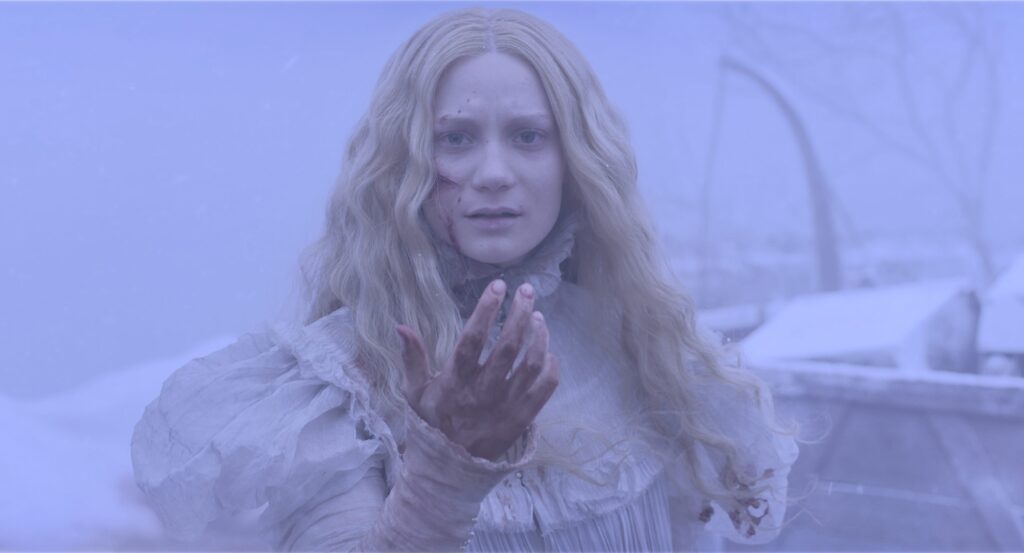There are only a handful of directors that I would say have a truly all-encompassing grasp on the films they make. Panos Cosmatos comes to mind, as does Dario Argento; no matter what you pick from their catalog, they have a total tonal cohesiveness. There’s something that bleeds through every ounce of their film’s cinematography, a signature on every frame. Guillermo Del Toro is one of those directors, possibly the preeminent among them, and Crimson Peak is certainly the film that embodies his cinematic signature best.
Discriminated against by publishers and rejected by socialites for her ambition, Edith Cushing can find no peace. But when a bold and charming inventor named Thomas Sharpe whisks her away, Edith’s troubles grow deeper. She’s taken to the Sharpe ancestral home, Allerdale Hall, a sinking mansion seated over a clay mine. Thomas and his quiet sister Lucille tend to its dusty halls. But as visions of grotesque red spirits begin to terrorize Edith, the manor’s history and who the Sharpes are, becomes clear quickly—and dangerously.
For the longest time I was told that Crimson Peak was a “slow-burn horror film”, but this is where language when describing movies is sometimes lost in translation for me. Crimson Peak isn’t what I would consider slow burn just because it’s quiet and not as frenetic as your typical supernatural horror. It’s briskly paced, there’s a mystery that unfolds at a steady rhythm, and there are quite a few encounters with the horrific ghosts of Allerdale Hall throughout the film (which are some of the best designed in film history, Mr. X Inc delivers when it comes to effects).
But in between all the phantasms and frights, there is a dark and uncomfortable romance unfolding that takes precedence. The film is far from unpredictable storywise, but it doesn’t really matter because the roughly 100-minute runtime breezes through, keeping you clung to the drama going on between Edith, Thomas, and Lucille. And when the tension between all three of them is relinquished, it feels less like waiting for a noise to sound off and more like the end of a high-strung violin performance.
If you’re a fan of gothic literature at all, this film has homages to it in spades, the most vocally beloved and represented here being Poe’s The Fall of the House of Usher. Del Toro has said as much, describing the film as “a cross between a classic gothic romance, like Jane Eyre […] and The House of Usher” in interviews. There are quite a few direct references to the events of Usher, including the mansion itself literally sinking into the earth, and its story elements like those that are incorporated which show you Del Toro’s love for gothic romance and his love for this film.
More visible signs of careful planning and execution are to be seen…well, in every other facet of the film. I’m about a decade late and a dollar short when it comes to clever analysis of how everything in this film is beyond gorgeous. But I will highlight that it won a Saturn Award for Best Production Design for a reason: Allerdale Hall is a breathing place, not breathing air but pure death. It’s not full of life, but a wispy, smokey unlife. There’s atmosphere pouring off its walls and stones like heavy bromine vapors. It’s up there as one of my favorite settings in all of horror, alongside the Overlook Hotel and Haywood Ranch.
It’s genuinely criminal that this film didn’t win any of the costume design awards it was nominated for, because they can be downright mesmerizing. They’re a key part of the film’s language, making many of the characters more visually striking and memorable. Chastain’s character, Lucille, arrives on the screen hailed by an outfit of deep red fabric that’s as rich and powerful as the classical music she plays on the piano. In this film, the costumes are a dramatic tool in and of themselves instead of just dressing for the performances, and I will always laud the ridiculously talented costume designer Kate Hawley for what she did here.
But of course, what is a stage without its players? I really can’t picture anyone else besides Tom Hiddleston and Jessica Chastain in this film, since they make the perfect duo; they both have so much gravity on screen it’s difficult to pull your eyes away. The movie belongs to them, given the kind of bombshell line deliveries they achieve. However, that’s not to discredit Mia Wasikowska, who shows off quite a bit of range as she goes through emotional torment after emotional torment.
Crimson Peak is the perfect film if you want to dissect and break down exactly how skilled a filmmaker Guillermo Del Toro is. Early in the film, Edith meets with a publisher, where she describes her novel as less of a ghost story and more of a story with ghosts in it. It’s very clearly a kind of unsubtle way for Del Toro to have an actress look at the camera and deliver his ethos on the film directly to you (there’s no way to make a meta line that verbatim says “the ghost is a metaphor” not sound kind of corny).
And while I would have disagreed with it in the past, Crimson Peak really is a perfect story about people where the ghosts serve the drama. I can honestly say this film could work without its more horrifying elements, that I can imagine a version of this film divorced from the supernatural, is a testament to the pure amount of craft Del Toro put into it. Unlike Allerdale Hall, Crimson Peaks is on solid ground and is some of Del Toro’s best directing yet.
